Want to take cuttings and root your NJoy pothos? Here is a complete guide on how to propagate NJoy Pothos in water or soil!
Pothos is one of the most popular houseplants because it is so easy to care for, grows quickly, and is super simple to propagate.
Another thing that I love about pothos plants is that they come in so many different varieties. They each have the easy care characteristics of the pothos, with their own unique looks.
Today I want to talk about NJoy pothos and share a step by step guide to NJoy pothos propagation!
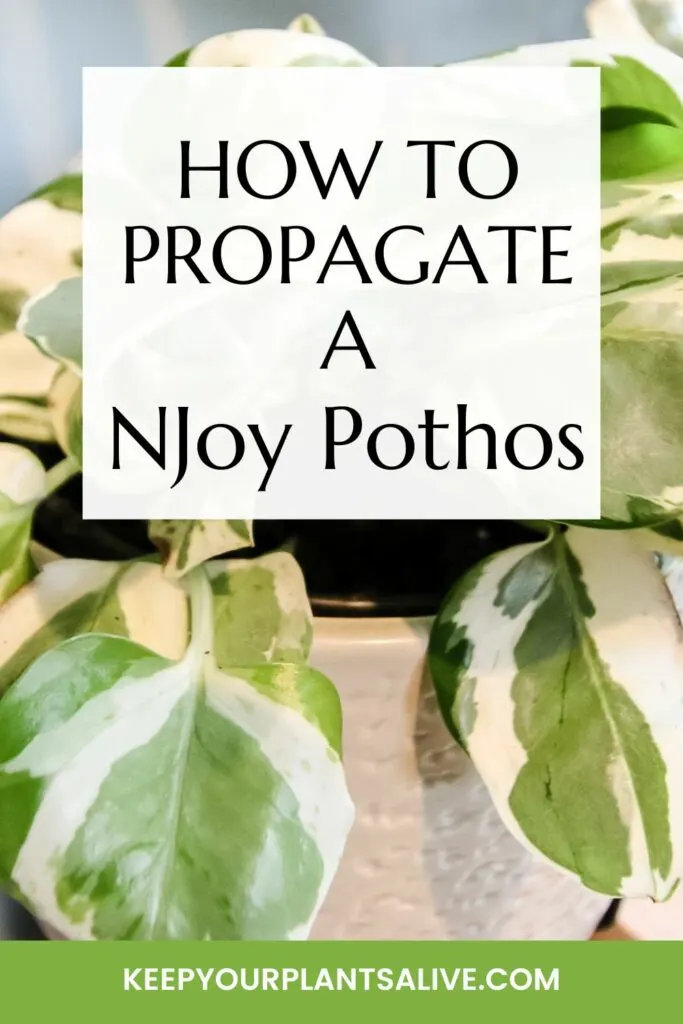
Understanding N’Joy Pothos
N’Joy Pothos is a variety of pothos with smaller leaves with lots of white variegation.
It is a cultivator of the Marble Queen Pothos. It was basically bred from the marble queen for a very similar plant, just with smaller leaves with even more variegation.
This plant naturally grows in the crooks of trees in the rainforest. So, their care needs mimic that of the rainforest: high humidity, warm temperatures, and bright, indirect lighting.
Overall, these plants are super easy to care for and do well in most indoor conditions, assuming that they stay warm and well-watered.
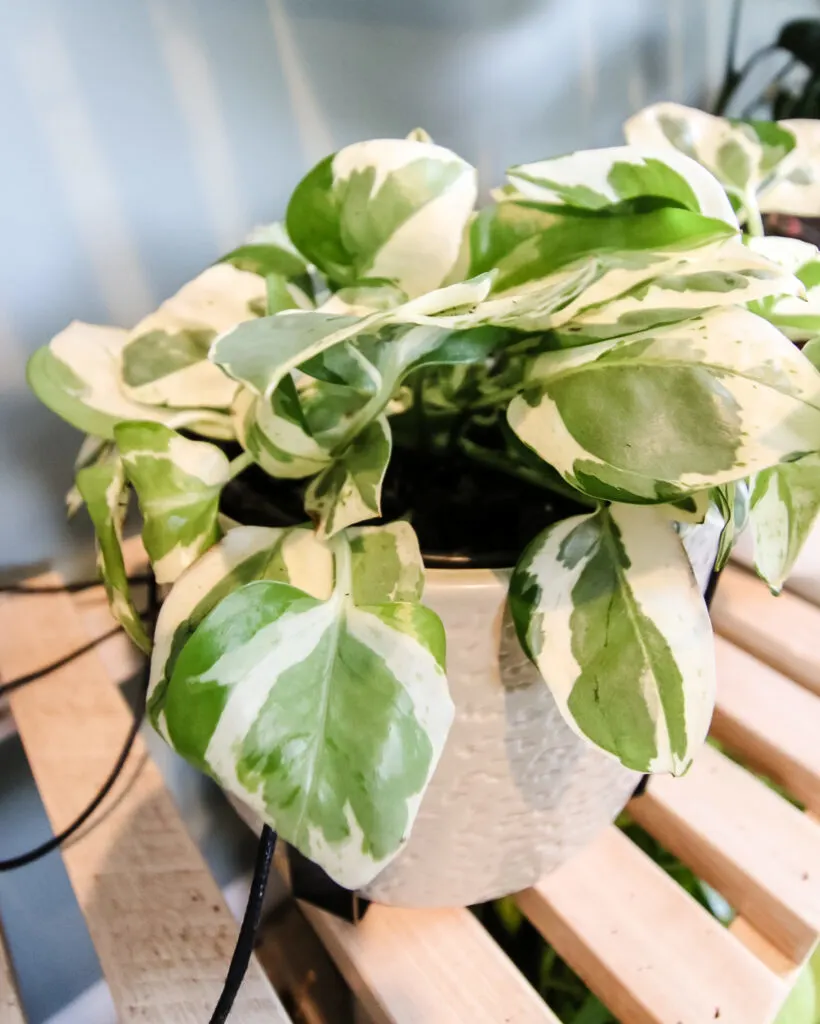
How to propagate an N’Joy pothos plant
You can propagate pothos cuttings in water, soil, LECA, or even sphagnum moss. Today we will focus on the two most common methods – water and soil propagation.
Water Propagation Step-by-Step Guide
I prefer to root my cuttings in water because it is super easy and you can visually monitor root growth.
- Select a healthy portion of the plant to take a cutting from, preferably with new growth
- Cut a section 3-9 leaves off of the plant with clean sharp scissors
- Remove any lower leaves, leaving no more than 2 leaves on the cutting
- Place in a jar of water
- Place in birght, indirect light
- The parent plant will sprout new growth at the last node on the plant. If there is a large segment of stem past the node, you might want to trim it off. This is purely aesthetic.
- Change the water in your jar once a week or when it gets foggy.
- You should see roots in 3-4 weeks.
- When roots are 2-3 inches long, move to soil and treat like another plant.
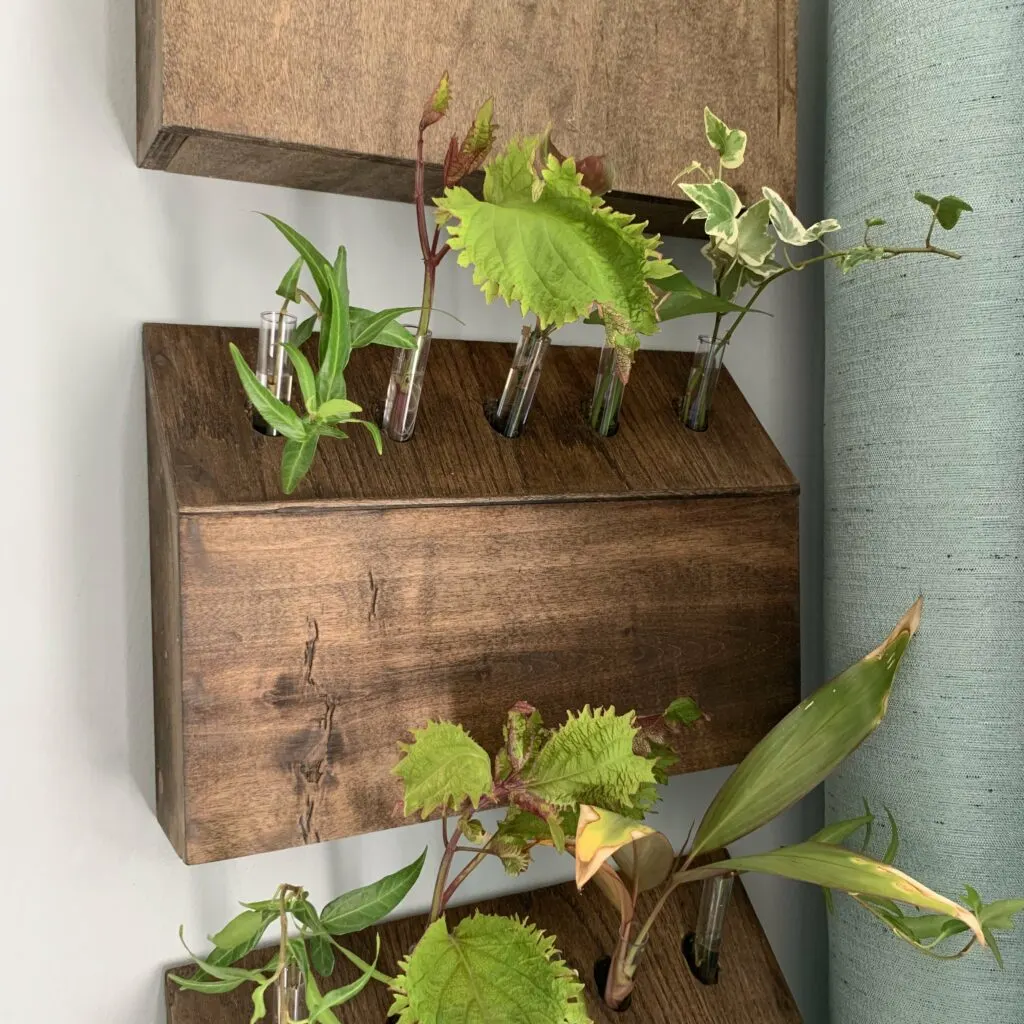
Soil Propagation Step-by-Step Guide
Some people prefer to root cuttings in soil because it eliminates the need to move cuttings from water to soil once the roots are established. You just have to be careful not to let them dry out!
- Select a healthy portion of the plant to take a cutting from, preferably with new growth
- Cut a section 3-9 leaves off of the plant with clean sharp scissors
- Remove any lower leaves, leaving no more than 2 leaves on the cutting
- Dip the cut end of the cutting into rooting hormone
- Place in a pot of moist soil
- Cover loosely with a clear plastic bag. This is optional but helps to increase humidity (like a greenhouse) and speeds up rooting.
- Place in birght, indirect light
- The parent plant will sprout new growth at the last node on the plant. If there is a large segment of stem past the node, you might want to trim it off. This is purely aesthetic.
- Remove the plastic weekly and water your plant.
- You should see roots in 3-4 weeks.
- After about 2 months, the cutting should be fully rooted in place. Remove the bag and treat like any other pothos plant.
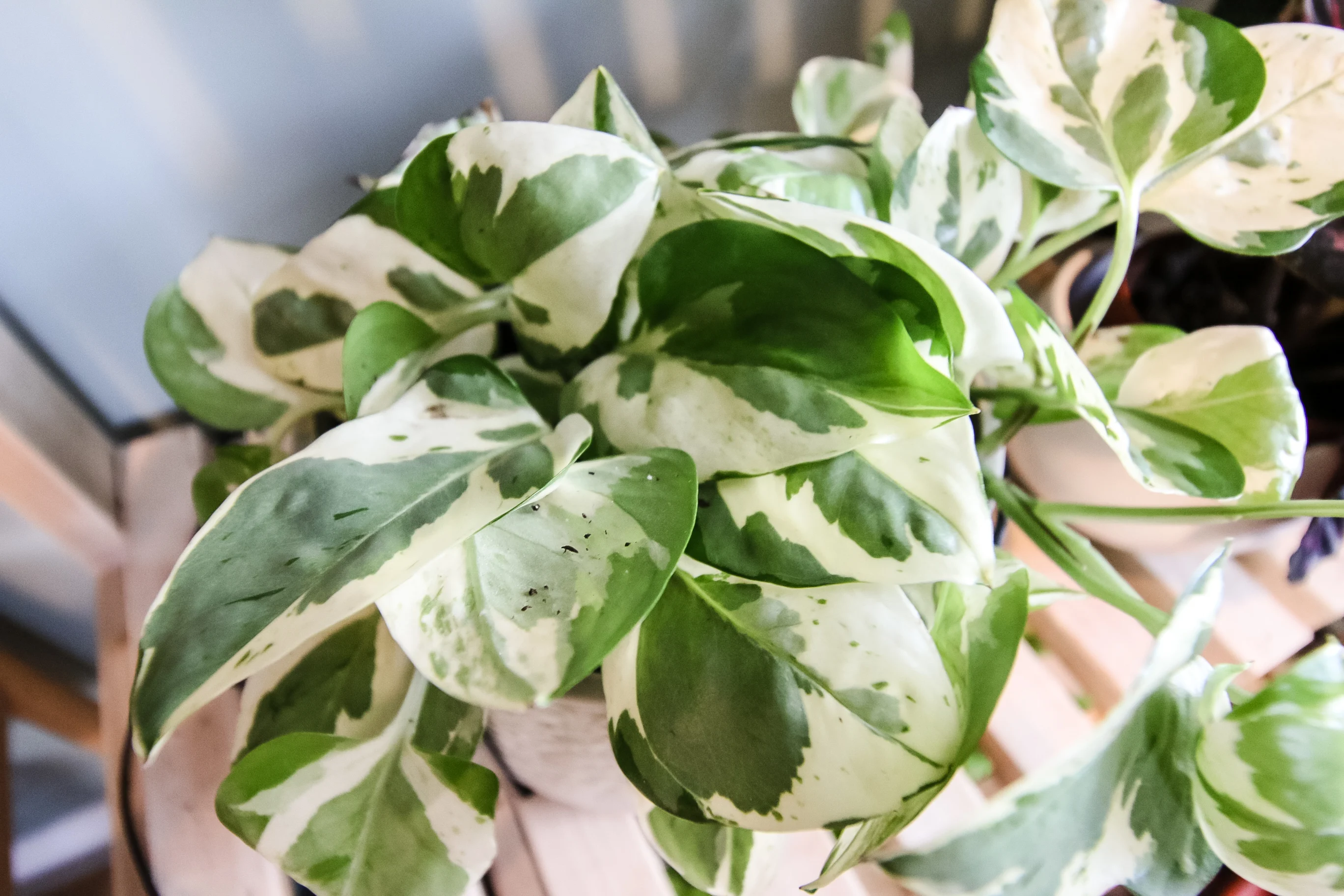
Dividing N’Joy Pothos
You can also propagate N’Joy Pothos via division. I divide my plants when they get root bound or outgrow their pots.
To divide your NJoy pothos plant:
- Gently pull the plant out of its pot
- Shake off any loose excess soil
- Use your fingers to gently untangle the roots and divide into 2 or more segments
- Re-pot in separate pots with proper drainage and fresh soil
- Care for as you would any other pothos plant!
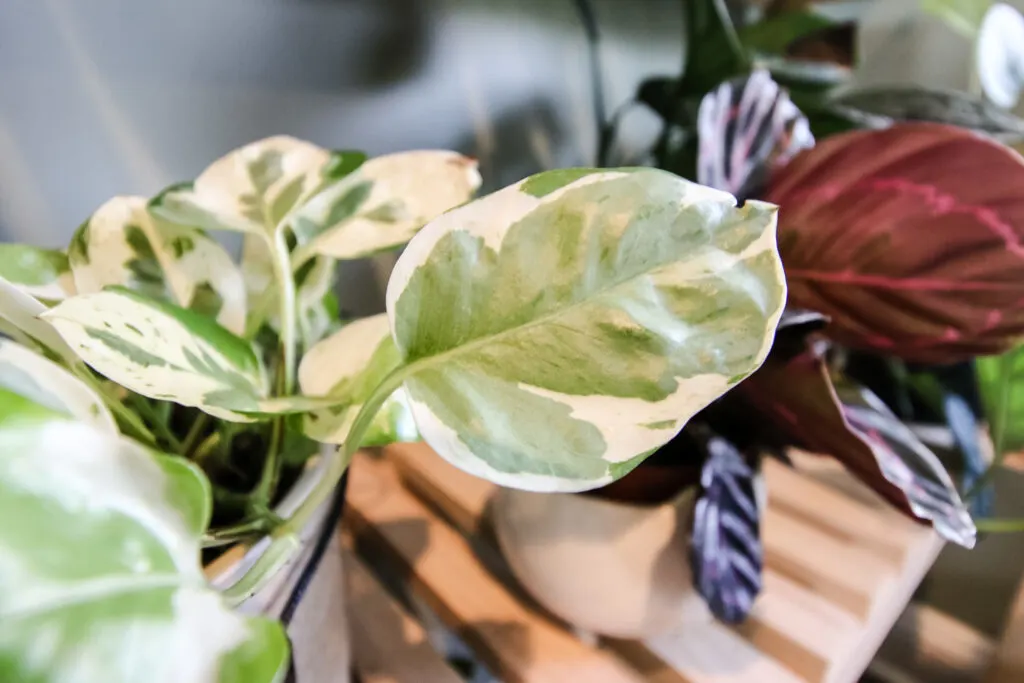
Troubleshooting and Tips
Here are some common issues that you might face during NJoy pothos propagation!
Yellowing Leaves
Yellow leaves can indicate overwatering, underwatering, or stress during propagation.
Check Watering: Adjust watering frequency. Ensure the soil is moist but not waterlogged. For water propagation, change the water regularly to prevent stagnation.
Light Exposure: Ensure the cutting receives indirect, bright light. Avoid direct sunlight, as it can scorch the leaves.
Temperature and Humidity: Maintain a consistent room temperature and humidity level. Sudden temperature fluctuations or dry air can stress the plant.
Slow Root Growth
Lack of root growth might be due to insufficient warmth, low humidity, or improper cutting selection.
Warmth and Humidity: Keep the cutting in a warm and humid environment. Consider placing a plastic bag or a clear plastic dome over the cutting to create a mini greenhouse effect.
Healthy Cuttings: Ensure you’re using a healthy cutting with nodes. Nodes are essential for root development. Consider taking multiple cuttings and experimenting with different nodes.
Root Rot
Root rot occurs due to overly wet conditions, leading to fungal growth that damages the roots.
Proper Drainage: Ensure the pot has drainage holes and well-draining soil to prevent water from accumulating at the bottom.
Reduce Watering: Allow the soil to dry out slightly between waterings. Overwatering is a common cause of root rot.
Trim Affected Roots: If root rot is detected, trim away the affected roots with sterilized scissors and repot the cutting in fresh soil.
Wilting Leaves
Wilting can result from underwatering, root issues, or transplant shock.
Watering: Ensure the plant is adequately watered but not sitting in water. Adjust the watering schedule as needed based on the moisture level of the soil.
Root Examination: Check the roots for signs of rot or damage. Healthy white roots indicate proper growth.
Transplant Care: If wilting occurs after transplanting, provide a stable environment with consistent light, temperature, and humidity. Avoid moving the plant frequently.
Pests and Diseases
Pests like aphids or diseases like powdery mildew can affect the cutting’s health.
Natural Predators: Introduce beneficial insects like ladybugs or use neem oil to control aphids.
Pruning: Remove affected leaves promptly to prevent the spread of diseases.
Isolation: If the cutting shows signs of disease, isolate it from other plants to prevent contamination.
By addressing these common issues and following the troubleshooting tips, gardeners can increase their chances of successful N’Joy Pothos propagation. Regular monitoring, proper care, and timely interventions are essential for nurturing healthy and vibrant new plants.
Before you go…
Unsure about moving your NJoy pothos cutting soil? Check out our complete guide on how to move pothos from water to soil!
Thanks for reading!


Hey there, I’m Morgan, a houseplant enthusiast from sunny Charleston, South Carolina. Growing up surrounded by my mom’s lush orchids and African violets, I discovered the magic of bringing nature indoors. Thanks to the pandemic, I delved deeper into houseplants, discovering their power to uplift moods and transform spaces. I’m here to spill all my secrets, helping you pick the perfect houseplant – and make it happy. Let’s keep your plants alive, together! 😊
